Book contents
- Frontmatter
- Contents
- Preface
- 1 Introduction
- 2 Analytical Foundations
- 3 The Estimation of Technical Efficiency
- 4 The Estimation and Decomposition of Cost Efficiency
- 5 The Estimation and Decomposition of Profit Efficiency
- 6 The Shadow Price Approach to the Estimation and Decomposition of Economic Efficiency
- 7 Incorporating Exogenous Influences on Efficiency
- 8 The Estimation of Efficiency Change and Productivity Change
- References
- Author Index
- Subject Index
1 - Introduction
Published online by Cambridge University Press: 05 June 2012
- Frontmatter
- Contents
- Preface
- 1 Introduction
- 2 Analytical Foundations
- 3 The Estimation of Technical Efficiency
- 4 The Estimation and Decomposition of Cost Efficiency
- 5 The Estimation and Decomposition of Profit Efficiency
- 6 The Shadow Price Approach to the Estimation and Decomposition of Economic Efficiency
- 7 Incorporating Exogenous Influences on Efficiency
- 8 The Estimation of Efficiency Change and Productivity Change
- References
- Author Index
- Subject Index
Summary
THE OBJECTIVES OF THE BOOK
A recent article in the Economist notes that most large European banks spend about two-thirds of their revenues on rent and employee expense. Credit Suisse and Deutsche Bank have expense ratios in excess of 70%. But Sweden's Svenska Handelsbanken has an expense ratio of barely 45%, despite relatively high wage rates. The article then proceeds to describe how, ever since a near-fatal financial crisis in the late 1960s, managements at Svenska Handelsbanken have striven to cut costs while, at the same time, increasing revenues. The impression one is left with is that, far from operating in a more favorable environment, Svenska Handelsbanken is more efficient than other large European banks. This and countless other examples raise the question of how conventional microeconomic theory and conventional econometric analysis deal with variation in productive efficiency.
Typical microeconomics texts develop models of production, cost, and profit in something like the following sequence. They begin with a production function, and producers are assumed to operate on their production functions, maximizing outputs obtainable from the inputs they use. First-order conditions for cost minimization are then introduced, and producers are assumed to satisfy these conditions, allocating inputs efficiently and ending up on their cost functions. Finally, first-order conditions for profit maximization are introduced, and producers are assumed to satisfy these conditions as well, allocating outputs and inputs efficiently and ending up on their profit functions.
- Type
- Chapter
- Information
- Stochastic Frontier Analysis , pp. 1 - 14Publisher: Cambridge University PressPrint publication year: 2000
- 6
- Cited by



